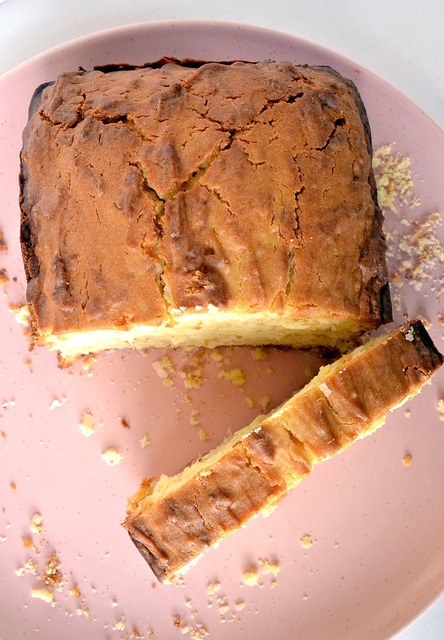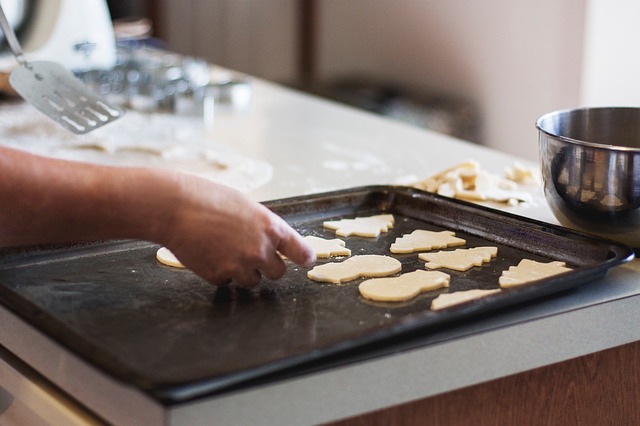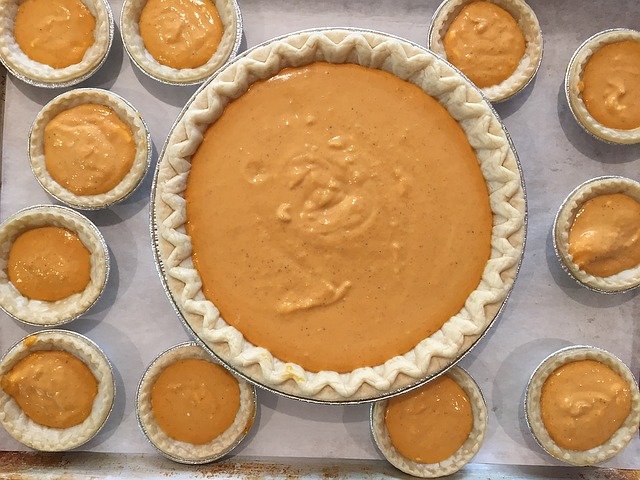Cooking Ahead for the Holidays: Desserts!
You don't have to wait until the night before to start cooking! You can take a little time during the weeks before to prep foods that will be delicious on the holiday...without the stress of running around trying to everything done!
Cooking Ahead for the Holidays: Desserts!
by Katie Cullum
Desserts are probably one of, if not THE, favorite thing about holidays! I love planning desserts - from Aunt Bessye's Pound Cake to Grandma's Orange Slice Cake to Aunt Chris's Teacakes. But you don't have to wait until the last minute for desserts. Start planning now for wonderful treats that will taste great but won't add stress.
Cakes

I love baking cakes! Sometimes, instead of making one big tube cake of pound cake, I split the batter into two loaf-sized pans. That way, I can freeze one for Christmas and eat the other for Thanksgiving!
To prevent crushing, place wrapped or bagged cakes in sturdy containers in the freezer. This is especially important if you just have the freezer with your refrigerator and not a separate freezer.
You can also freeze slices of cake by putting a double layer of freezer wrapping between slices. Avoid cream-type fillings as these often decline in quality when frozen. You can freeze unfrosted or frosted cakes!
Wrap UNFROSTED cakes BEFORE freezing. Frost AFTER the cake is thawed. Thaw unfrosted cakes in their original wrapping at room temperature.
For FROSTED cakes - the best frostings for freezing are fudge frostings and uncooked powdered or confectioner's sugar frostings made with fat. Cooked frostings, seven-minute frostings and other egg-white-based frostings don't freeze well. Freeze frosted cakes BEFORE packaging to prevent the wrapping from sticking to the frosting.
Thaw frosted cakes in the refrigerator. Remove the wrapping so it won't stick to the frosting as the cake thaws. Thaw the unwrapped cake on a serving plate in its protective container or cake-keeper. This prevents possible cross-contamination from other foods and accidental damage to the delicate frosted surface as you add and remove refrigerated items. If space is limited, place the cake on the top shelf uncovered.
Angel Food, Chiffon, Sponge, Layer, Loaf, Cupcakes - prepare and bake as usual. Cool completely. Wrap tightly and then store in a sturdy container for protection.
Suggested freezer storage time: varies, about 2-3 months should be satisfactory for most cakes.
Cookies

Start baking those cookies up to a month before you need them. For freezing, it's best to stick with your normal cookies and not try to freeze fragile cookies, meringue-based cookies, or cookies containing beaten egg whites such as macaroons.
Cool cookies thoroughly. Pack in a rigid container to help keep them from breaking. Place moisture-vapor-resistant freezer wrapping between layers. Choose a container that is just right - not too big! Too much air can lower the quality of the food. Use more freezer wrapping to fill in space if needed.
Suggested freezer storage time: 3 to 6 months.
Candy
Make as usual and freeze. Most candies freeze well. One notable exception is chocolate covered cherries. The filling may expand during freezing and break open the candy. Wrap candies individually in freezer plastic wrap and place in a rigid container to prevent crushing. Thaw, wrapped, at room temperature. A whitish fat "bloom"may appear on the surface of chocolate during freezing. This should disappear after candy is thawed.
Suggested freezer storage time: 6 to 8 months.
Pies

What types of pie DON'T freeze well? Meringue toppings toughen in the freezer. Custard and cream pies get watery after thawing and aren't recommended for freezing.
Pans - Choose a pan suitable for the freezer, such as the disposable aluminum foil pie plates found in many supermarkets, or rust- proof metal pie pans. Freezer/ovenproof glass also might work but needs to be handled with more care. If you usually use your glass pie pan, but want to freeze that pie in an aluminum pie plate, test out the volume first! An easy way to obtain a general idea of differing volumes is to fill your regular pie pan with water. Then pour the water into the foil pan. Measure the amount of liquid left in your regular pan; reduce the amount of filling by about that much.
A soggy crust can be a problem with frozen filled pies. Brush the inside of the bottom crust lightly with melted butter or margarine before adding the filling to help prevent a soggy crust.
As filled pies are higher in moisture content and take longer to cool/heat/reheat than many baked goods, pies can be trickier to freeze than many foods. The best advice: Do a trial run with freezing a favorite pie BEFORE you freeze it for a special event. Here are an assortment of tips that may help you decide how to most successfully freeze your favorite pies.
Unbaked Pie Crust -- Prepare your regular crust recipe. Place in a freezer-suitable pie plate. If the pastry will be baked unfilled, prick the bottom of the crust in several places. Stack the pie pans, separating them with two layers of freezer paper. Put in a freezer bag or overwrap with aluminum foil. To use, while still frozen, bake at 475 F until light brown (about 8 to 10 minutes) or add filling to the frozen crust and bake as usual.
Suggested freezer storage time: 6 to 8 weeks.
Fruit, Mince, Nut Pies, Unbaked -- Prepare as usual. The flavor of a pie is fresher when it's frozen before baking. Some sources suggest using quick-cooking tapioca to thicken pie filling instead of your usual thickener. Cornstarch and flour are more likely to separate when the pie is thawed.
Here are some general guidelines if you'd like to adapt your recipe for quick-cooking tapioca: Approximately 1 tablespoon of quick-cooking tapioca is equal to 1 1/2 teaspoons cornstarch or 1 tablespoon flour. Mix the fruit, tapioca, sugar and flavorings and let stand in a bowl for 15 minutes before placing in your pie shell. This helps the tapioca hydrate and absorb the fruit juice. If you find that juicier pies tend to boil over more when baked from the frozen state, add an extra tablespoon of tapioca next time.
When freezing unbaked pies with light-colored fruits -- such as apples, peaches, pears and apricots -- be aware these fruits may turn dark. The quickest way to prevent this is to treat them with a commercial anti-browning product for fruit, such as Ever-Fresh (TM) or Fruit-Fresh (R). These are found in most supermarkets in the food preservation supplies section. Follow package directions.
Do not cut vents in the top crust before freezing. When ready to bake, cut vents in the upper crust. Place pan on a foil-covered cookie sheet and bake without thawing at 450 F for 15 to 20 minutes. Placing a cookie sheet under the pie helps it bake more evenly and protects your oven should any juices bubble over. Then bake for 20 - 30 minutes at 375 F until the top crust is brown. As pies, pie plates and ovens vary, adjust time and temperature as needed.
One method to help determine doneness is to check the tenderness of the fruit by cutting into the pie through a steam vent with a sharp knife. If the edges of your pie crust are browning too quickly, crimp strips of foil, shiny side up, around the rim of your crust. About a 2-inch wide strip should be sufficient for covering your crust edges.
Suggested freezer storage time: 3 - 4 months.
Fruit, Mince, Nut Pies, Baked -- Make as usual. Cool as rapidly as possible on a wire cooling rack. (Note: Pies baked in metal rather than glass pie plates will cool faster.) Freeze and then wrap. It's easier to wrap a pie after freezing.
To serve, thaw in the refrigerator and serve chilled or reheat in a 325 F oven until warm. As a test of when your pie has warmed, "Joy of Cooking" (Scribner) suggests heating until a knife inserted through a steam vent on top of your pie comes out warm. As recommended for unbaked pies, cover edges with foil if they start browning too rapidly during reheating.
Suggested freezer storage time: 3 - 4 months.
Pumpkin Pie -- If you'd like to prepare pumpkin pie ahead, it's easiest and safest to freeze just the crust. Add the filling to the frozen crust just before baking and bake as usual. It takes just a few minutes to mix together the ingredients. As pumpkin pie is a perishable food and shouldn't be left at room temperature more than two hours, your pie is safer to eat when you bake it the day of your meal. Also, the quality of a freshly baked homemade pumpkin pie is usually higher than a frozen one.
Cheesecake, Baked
Make as usual, bake and cool as rapidly as possible on a wire cooling rack. As cheesecake is a perishable food, it shouldn't be left at room temperature more than 2 hours. After the first hour of cooling, transfer to the top shelf of your refrigerator to complete the cooling. Place in a location where cross-contamination won't occur. Freeze unwrapped, then wrap and place in a rigid container to protect from crushing. Thaw wrapped cheesecake in refrigerator.
Suggested freezer storage time: 4 weeks.
Check out the other post in this series - Cooking Ahead for the Holidays: Breads.